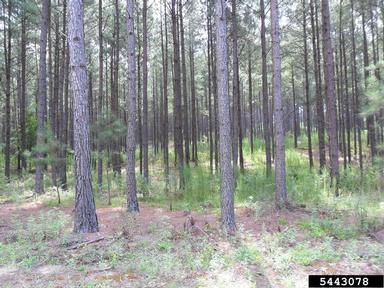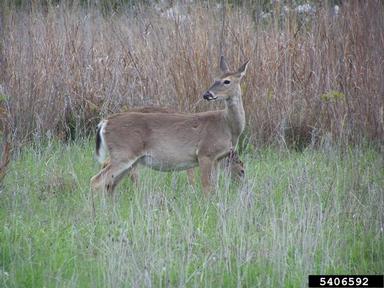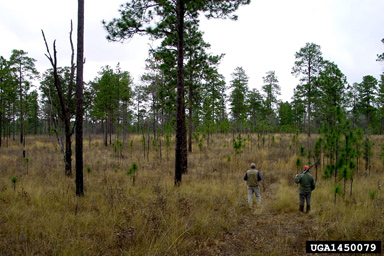Managing Pines in Arkansas
Managing Your Pine Timber in Three Easy Steps
If you own pine timber, you own a potentially profitable investment. Profitability
is often measured in terms of dollars; but it can also be measured in terms of wildlife
habitat produced, clean water produced, ownership satisfaction, or many other values
or combinations of values you may choose.
Step 1 in managing pines
The first step to managing your pine timber is to decide what value you want from your timber and how you want to measure the value.
What benefits do you want your pine timber to produce? Deciding which benefits you want from your timber can be difficult.
There are many possibilities and often some limitations to the values that your timber can produce. Often two or three values can be produced from the same stand of timber if you can find an acceptable balance of production among the values. You can't produce 100% of both or all three values, but you can produce some of each.
Examples of some of the values your land can produce include income from timber production or hunting leases, hunting opportunities for yourself or family, a home site for yourself, habitat for an endangered species, or water quality protection for streams or lakes. Many of these goals are compatible, but there can be conflicts. It is almost always necessary to give up maximizing a primary goal to add a secondary goal.
Sometimes there are limitations that will affect the choices you make about the values your pine timber will produce. One of the most common limitations is low site index.
What is low site index?
Site index is a measure of site fertility. When site index is low, the ability of the site to produce timber will be low. Sites with a low site index may be more suitable for certain types of wildlife habit than for others. Goals may also conflict. For example, pine plantations provide good wildlife habitat at some stages of development, but they do not provide ideal wildlife habitat as mature closed-canopy stands.
Regardless of the value measure you choose for your pine timber, good management can enhance the value.
"Good management" will depend on what you want from your pine timber. Managing a
pine stand is not complicated, but there are things that need to be done and done
at appropriate times to maintain the productivity of the stand and realize its full
value.
Step 2 in managing pines
The second step to managing your pine timber is to find out what you have.
So what do you have? Yes, you have a stand of pine timber; but what are the attributes of that stand? How old is it? How many trees are there? How big are the trees? Is the stand in good health? Are there any pest or disease problems? What are the capabilities of that site? What else is growing in that stand? What animals are living in that stand? Are there any unique features or cultural resources that must be considered?
All of these questions and more need to be answered before you can plan what you need to do to your pine stand to maximize its value. You can answer many of these questions yourself, but some need to be answered by someone who is trained to measure and evaluate forests.
The fact sheet Consulting Foresters for Private Landowners explains how to find and hire a consulting forester.
Talk to a consulting forester about your goals and the values you want your pine timber
to produce. Once the forester knows what you want, he or she can design a plan to
get answers to your questions. Part of that design will be a timber cruise and will
include a site map so that you know where resources are. Additional information may
be collected by the forester as necessary to adequately plan your forest management
to meet your goals.
Step 3 in managing pines
The third step will be to write your plan.
You should have a written plan so you can maintain continuity in your management. Fifteen years from now, it will be hard to remember what you had planned for year sixteen. Each site is different and there are many different possible goals.
A management plan is a prescription that is unique to the site and the landowner.
The fact sheet Managing Loblolly Pine Stands . . .from A to Z discusses some of the tools and techniques used to manage pine timber. Note that the fact sheet discusses loblolly pine management for timber production, but the same tools are used to manage loblolly pine for other goals, as well.
A professional forester can write a prescription to help you achieve your goals.
The Arkansas Forestry Commission may be able to help you obtain a forest management plan. Contact your county AFC
office for more details.
Finances for managing pine forests
Whether we like it or not, managing land and timber involves managing finances. Regardless of your ultimate ownership goal, the activities necessary to keep the stand moving toward the goal must be financed.
Timber sales are more appropriately conducted for biological reasons with the income as a secondary benefit. Healthy pine stands continually grow. As they grow, pine stands become overcrowded, stressed, and more susceptible to insect and disease problems. To reduce the amount of standing timber and maintain the health of the stand and keep it moving toward the landowner's goal, it will become necessary to occasionally thin the stand.
In those cases, the income produced is a secondary benefit that should be used to finance the activities necessary to keep the stand moving toward the landowner's goal. It is important to note that some of the best known land-owning environmental organizations have foresters on staff to manage their lands, including thinning forests.
You can find more information about marketing your timber and handling forestry finances on the Marketing Your Timber page. If you'd like to ask some questions about managing pine forests, please contact your county Extension agent or our Extension forester:
Publications
- Improve Your Pine Stand by Thinning
A description of the techniques and benefits of thinning pine stands.
- Making Sense of Loblolly Pine Seedling Varieties
A description of the modern loblolly pine seedlings available to private landowners.
- Site Preparation Methods for Establishing or Re-establishing Pine Stands
A description of the modern loblolly pine seedlings available to private landowners.
- Storing, Handling and Planting Southern Pine Seedlings
A description of the proper techniques to store, handle, and plant pine seedlings.
- Why We Burn: Prescribed Burning as a Management Tool
A explanation of prescribed burning as a forest management tool.
- The Clean Air Act and Prescribed Fire: What It Means for Arkansas
A explanation of the impact of the Clean Air Act on prescribed burning.


